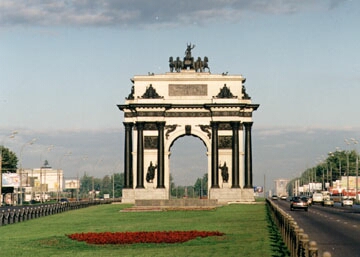|
|||
|
Philatelia.Net / Bonapart / Plots / The directory «Plots of stamps in the catalogue»The Triumphal ArchIn the middle of 1814, a wooden Triumphal Arch was built beside the Tver Gates (at the end of present-day Gorky Street) for the solemn meeting with the victorious Russian troops returning from West Europe. The monument quickly became dilapidated and twelve years later, in 1826, the decision was made to replace the wooden Triumphal Arch with a stone one. The prominent Russian architect Osip Bove drafted a project the same year. But the decision about new planning of the parade square at the entrance to Moscow from Petersburg was made and the initial project needed readjustment. The new variant, on which Bove worked for almost two years, was adopted in April 1829. The construction of the Triumphal Arch (the first and only monument erected after the war of 1812 in Moscow that was in the form of an arch) stretched out for five years because of lack of money and the indifference of the municipal authorities. Only on September 20, 1834 did the opening take place for this distinctive monument, which reflected the military power, glory and greatness of Russia and the heroism of its victorious soldiers. Bove created a bright and expressive image of unbowed Moscow arisen "from ashes and ruins," as it was written on one of the inscriptions on the arch. The Triumphal Arch stood near the Tver Gates for 102 years. In 1936, the Soviet government decided to re-plan the square near the Belorussia Station and widen it to relieve transport traffic between Gorky Street and the Leningrad main road. The Triumphal Arch, the guardhouses (buildings for the military sentries) and the remains of the forged fence were pulled down. The rich sculptural decoration of the arch was kept for 32 years in the branch establishment of the Shusev Museum of Architecture on the grounds of the former Donskoy Priory. Even now you can see, to the right from the north entry in Great Cathedral, fragments of the old moldings, cast-iron plaques with reliefs of military armor and heraldic devices, the base and the capital of one of the columns. In 1966 the Moscow Council of Labor Deputies made the decision about reconstruction of the Triumphal Arch at a new location. The architectural group of the Seventh Workshop of "Mosproject-3" worked out the details of the project. The task before them was not easy: in a single one of the cornices which crowned the arch, it was necessary to place 1276 independent details. The architects, artists and engineers had the prospect of reconstructing the initial appearance of the monument using preserved measurements, drawings and photographs and filling in the missing ornamental elements. The Triumphal Arch is a beautiful symbol of victorious Moscow, inbued with the idea of the triumph of the Russian people. It is the main monument of the Patriotic War of 1812 in the Russian capital of Moscow. Kyrgyzstan, 2012, Triumphal Arc in Moskow Russia, 1992, The Triumphal Arch Russia, 1992, The Triumphal Arch Russia, 2012, Triumphal Arch USSR, 1981, Horse tram, The Triumphal Arch USSR, 1987, Borodino Battle German Federal Republic, 2002.09.20, Russia, 1997, Russia, 2012, USSR, 1970, USSR, 1978, USSR, 1981, USSR, 1984, USSR, 1985, USSR, 1985, Russia, 1998, Russia, 2003.06.20, Russia, 2009, USSR, 1969.07.24, USSR, 1972.04.21, USSR, 1972.06.22, USSR, 1982.09.23, USSR, 1984, Advertising: |
|||
© 2003-2025 Dmitry Karasyuk. Idea, preparation, drawing up
|

